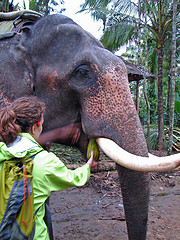Elephas maximus
What do these gigantic creatures eat?
The Asian elephants are among the largest herbivores on the earth’s surface, feeding on a variety of vegetation.
They prefer to eat grasses, but they also eat bamboo, bark, roots, leaves, and fruit. They especially like to consume coconuts, sugar cane, berries, and bananas.
Asian elephants spend the majority of the day collecting and consuming food except during extremely hot temperatures when they rest. An average day’s food intake is anywhere from 150-300 kg, or about 6-8% of their body weight. However, only about 4% of their food is actually digested. They also drink up to 40 gallons or 150 liters of water a day.
The mouth of the elephant is relatively small compared to the size of their body but they have well-developed salivary glands along with mucous glands in the esophagus that helps them to digest fibrous vegetation. The elephant has a cylindrical shaped stomach, and a simple digestive system. The food is stored in the stomach which doesn’t do much digestion; it acts primarily as a storage site. The food is fermented by bacteria in the caecum, which is a small sac between the small and large intestines. The caecum has many partitions and the thin walls contain many vessels and ducts through which nutrients are absorbed. Fermentation of cellulose takes place in the caecum. The digestive system is not very efficient because the food passes through the digestive system quickly before nutrients are absorbed, resulting in expulsion of about 60% of the food they consume.To overcome this inefficiency they eat large quantities of food.
Elephants use their trunks to grasp food and suck water and eventually bring it to its mouth. They also use their tusks to move vegetation around so that its more accessible.
Tusks can also be used to rip bark off of trees and to dig for food and water. Due to their massive size, elephants can also knock down large trees by ramming into them so that they can eat vegetation like leaves and branches that grow on them.


